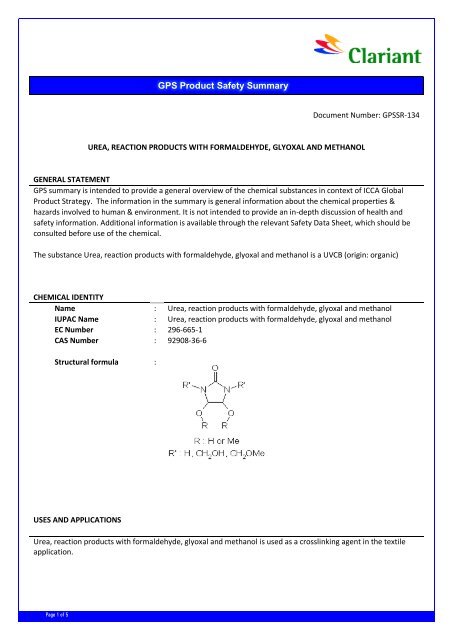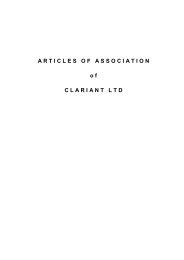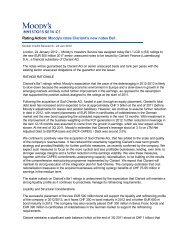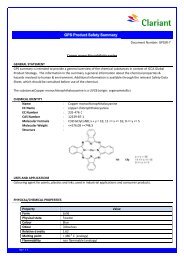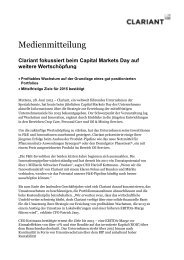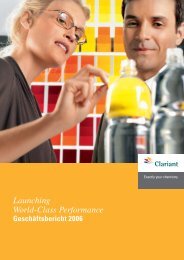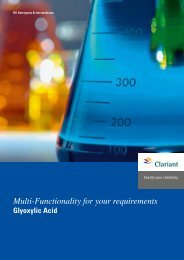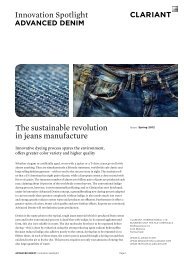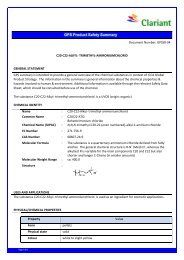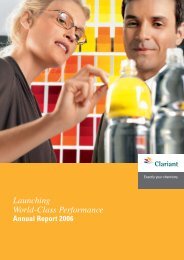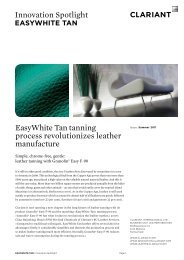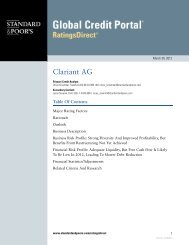GPS SUMMARY REPORT 134 UREA-FORMALDEHYDE ... - Clariant
GPS SUMMARY REPORT 134 UREA-FORMALDEHYDE ... - Clariant
GPS SUMMARY REPORT 134 UREA-FORMALDEHYDE ... - Clariant
You also want an ePaper? Increase the reach of your titles
YUMPU automatically turns print PDFs into web optimized ePapers that Google loves.
<strong>GPS</strong> Product Safety SummaryDocument Number: <strong>GPS</strong>SR-<strong>134</strong><strong>UREA</strong>, REACTION PRODUCTS WITH <strong>FORMALDEHYDE</strong>, GLYOXAL AND METHANOLGENERAL STATEMENT<strong>GPS</strong> summary is intended to provide a general overview of the chemical substances in context of ICCA GlobalProduct Strategy. The information in the summary is general information about the chemical properties &hazards involved to human & environment. It is not intended to provide an in-depth discussion of health andsafety information. Additional information is available through the relevant Safety Data Sheet, which should beconsulted before use of the chemical.The substance Urea, reaction products with formaldehyde, glyoxal and methanol is a UVCB (origin: organic)CHEMICAL IDENTITYName : Urea, reaction products with formaldehyde, glyoxal and methanolIUPAC Name : Urea, reaction products with formaldehyde, glyoxal and methanolEC Number : 296-665-1CAS Number : 92908-36-6Structural formula :USES AND APPLICATIONSUrea, reaction products with formaldehyde, glyoxal and methanol is used as a crosslinking agent in the textileapplication.Page 1 of 5
<strong>GPS</strong> Product Safety SummaryENVIRONMENTAL EFFECTSEnvironment Safety AssessmentNo environmental classification is proposed since no (adverse) effects have been observed in the ecotoxicologicaltesting (see below). Furthermore the substance is evaluated to be not PBT (persistent, bioaccumulative, toxic) orvPvB (very persistent, very bioaccumulative).Effect AssessmentFish toxicityDaphnia toxicityAlgae toxicityBacteria toxicityNot toxic to fishNot toxic to daphniaNot toxic to algaeNot toxic to bacteriaResultsFate and BehaviourBiodegradationBioaccumulationpotentialPBT / vPvB conclusionNot readily biodegradableNo bioaccumulation potentialNot PBT or vPvB substanceResultsEXPOSUREHuman Health :Consumers will not come into contact with Urea, reaction products with formaldehyde, glyoxal and methanol asit is manufactured in a closed process which also minimizes employee exposure potential. Consumer exposure isnot relevant since the substance is covalently bound to textile.Exposure to Urea, reaction products with formaldehyde, glyoxal and methanol of personnel in manufacturingfacilities is also considered very low because the process, storage and handling operations are enclosed.Environment :Urea, reaction products with formaldehyde, glyoxal and methanol does not fulfill the criteria for classificationand labelling as "hazardous to the aquatic environment" according to Directive 67/548/EEC and Regulation1272/548/EEC.RISK MANAGEMENT RECOMMENDATIONSThe substance Urea, reaction products with formaldehyde, glyoxal and methanol, is not a dangerous substance &there is no risk to humans or the environment.When using this chemical, make sure that there is adequate ventilation. Always use appropriate chemicalPage 3 of 5
<strong>GPS</strong> Product Safety Summaryresistant gloves to protect your hands and skin and always wear eye protection such as chemical goggles.Do not eat, drink, or smoke where chemicals are handled, processed, or stored. Wash hands and skin followingcontact. If the substance gets into your eyes, rinse eyes thoroughly for at least 15 minutes with tap water andseek medical attention.All effluent releases that may include the substance must be directed to a (municipal) waste water treatmentplant that removes the substance from the final releases to the receiving waterSTATE AGENCY REVIEWThis substance has been registered under REACH.REGULATORY INFORMATION / CLASSIFICATION AND LABELLINGLabeling according CLP regulation (Regulation (EC) No. 1272/2008, as amended):Based on available data : Conclusive but not sufficient for classificationSignal word :No signal wordCONCLUSIONCONTACT INFORMATION WITHIN COMPANY<strong>Clariant</strong> Produkte (Deutschland) GmbH65926 Frankfurt am MainTelephone no. : +49 69 305 18000GLOSSARYAcute toxicity: harmful effects after a single exposureBiodegradable: breakdown of materials by a physiological environmentBioaccumulation : accumulation of substances in the environmentCarcinogenicity: effects causing cancerPage 4 of 5
<strong>GPS</strong> Product Safety SummaryChronic toxicity: harmful effects after repeated exposuresClastogen: a substance that causes breaks in chromosomesEmbryotoxicity: harmful effects on foetal healthGHS: Global Harmonized SystemHazard: situation bearing a threat to health and environmentMutagenicity: effects that change genesReprotoxicity: combining teratogenicity, embryotoxicity and harmful effects on fertilitySensitising: allergenicTeratogenic: effects on foetal morphologyDATE OF ISSUEOctober 2011REVISIONADDITIONAL INFORMATIONDISCLAIMERThe information contained in this paper is intended as advice only and whilst the information is provided inutmost good faith and has been based on the best information currently available, is to be relied upon at theuser’s own risk.No representations or warranties are made with regards to its completeness or accuracy and no liability will beaccepted by <strong>Clariant</strong> for damages of any nature whatsoever resulting from the use of or reliance on theinformation.Page 5 of 5


